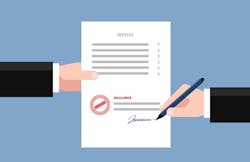Picture this: A customer comes in your shop to get new rotors. While you’re completing the job, you notice the rear brake pads are slim to none, making the vehicle unsafe to drive. You alert the customer of the issue and they kindly decline the service, saying, “I’ll bring it in another time.” About a mile out from the repair shop, the customer’s brakes give way, causing them to get into an accident.
As an auto repair shop, will you be held responsible? And, what if the customer comes back and blames you for the accident when you told him or her the issue and recommended it be fixed? How can you not be held liable?
Growing up as a technician in the industry, William Ferreira knows about this scenario. When he left the trade and went off to law school, former colleagues—mechanics and shop owners—were having legal troubles of their own, so he decided to step in and help. Based in San Francisco and Los Angeles, he is now the lead attorney of Automotive Defense Specialists, representing only auto repair and auto body facilities—no accident cases involved—with 10 years of experience under his belt.
To help alleviate any confusion, Ratchet+Wrench spoke with Ferreira on how auto repair shops can avoid being held liable in these types of situations.
The biggest issue is if someone finds something and doesn’t tell them. I have had customers that have tried to hold the shop liable. Generally speaking, the shop usually avoids liability. Most shops are vested in checking things out and finding something wrong to recommend another service to them. If they see something, they’ll say it, and if they don’t see it, it’s because it’s not in view. If it is unrelated to the repair, a shop cannot be held liable. Is it the duty to inform the consumer of an unsafe condition on vehicle? Yes, of course, but only if you see it. You could spend two weeks with a car to make sure that everything is working correctly.
One thing that you worry about, especially in California, is the Bureau of Automotive Repair doesn’t want you scaring the customer into a repair. If you say it’s an unsafe vehicle to operate, it better be unsafe to operate. You don’t want to say something that’s untrue. There are key things that could get a customer to recognize that this is a dangerous piece of equipment and the things I am telling you are not because I’m trying to make a quick buck off of you, but because it is necessary to keep you and your vehicle safe. Let’s say you’re pulling off a wheel to do a brake job, and literally a rotor disintegrates in your hands. You can’t put it back together; nobody would put it back together and put it on the road. You tell the customer what happened and they accuse you of being a crook and they want to take their vehicle somewhere else. To avoid liability in these circumstances, I would say to the customer that you are not letting this vehicle leave unless it gets fixed or it leaves on a tow truck, and if somebody finds out you put the wheel back on the car and it kills someone, that’s the last thing you need on your conscience.
An explanation of how the vehicle operates and taking a few minutes to explain to the customer why it’s important and how it’s important to the safety of the vehicle is the way to go. Usually, that kind of gets their attention. Spending a couple extra minutes and even bringing them out to the car and physically showing them where the problem is, and showing them what it’s supposed to look like gives them a visual representation and will help them understand more. It brings it from, “I don’t know anything about this; I’m afraid they are trying to sell me something I may not need,” to, “I understand, and I am comfortable with why the repair is necessary.”
I would have a disclaimer on every single invoice related to recommended repairs. Generally speaking, I would write on every invoice, “It may be unsafe to operate this vehicle on streets or highways in its current condition. We recommend XYZ repairs, and the shop makes no claim regarding the safe operation of the vehicle in its current condition due to the above issues.” And I would also say, “A driver/owner is responsible for any damages as a result of continuing to operate this vehicle in its current condition.” What that does is explicitly tells the customer there is something we found here that we feel is unsafe, we’ve told you about it, we don’t recommend you drive it, and if you do, you’re on your own. And at the bottom, have them sign it as proof.
Have your paperwork in order. I don’t care if it’s five, 10 years later—you’ll still have some customer or some lawyer saying you worked on their vehicle 10 years ago and probably failed to do something correctly, so let’s sue them as well. If you have your paperwork in order and have those documents that say you recommended the repair, those types of documents would deflect the blame or the liability to the customer that failed to do something that was recommended by a qualified mechanic.

